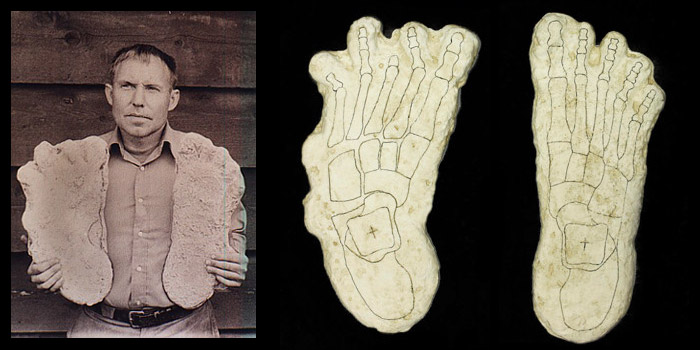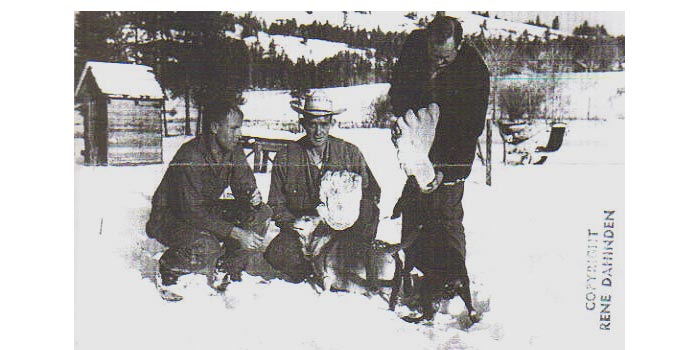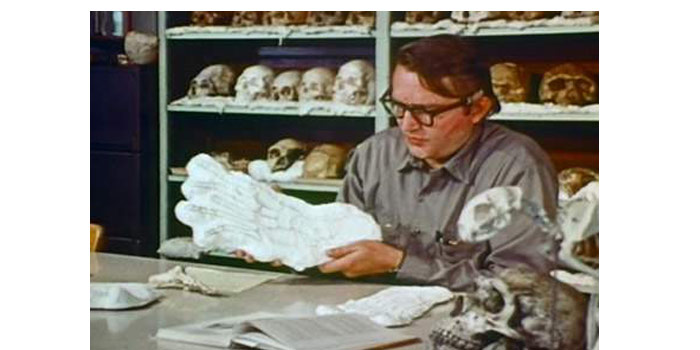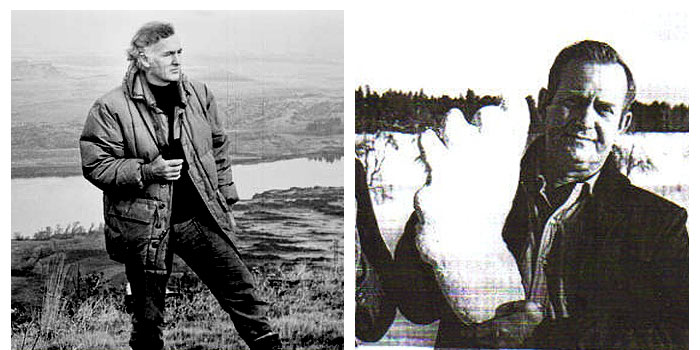
Rene Dahinden holding the “cripplefoot cast”, 1970
Right beside the famed 1967 Patterson/Gimlin footage, many enthusiasts believe the other pillar of irrefutable Bigfoot evidence to be the 1969 Bossburg, Washington cripplefoot tracks. In this small community just south of the Canadian border, at least 1089 individual footprints were discovered by a enthusiastic team of Bigfoot hunters. On the surface these appetizing pieces of evidence are remarkable, but what is the real story? The Patterson/Gimlin footage ignited a fever among Bigfoot hunters in 1967, and just two years later these tracks once again hypnotized researchers. But does this unique piece of Bigfoot evidence truly hold that much weight? In this case, it’s essential to look beyond the footprints, right into the eyes of several overzealous Bigfooters.
What events lead to the cripplefoot cast?
In November of 1969 notable researcher Rene Dahinden received a phone call from colleague John Greene. Greene explained that a fellow Bigfooter named Ivan Marx was tracking a crippled Sasquatch, evidenced by a malformed foot print found in the mud by a butcher around the town dump. Rene traveled to Bossburg to investigate. Though trampled by curious locals, the muddy grounds around the dump did yield at least one complete footprint preserved beneath a cardboard box. Rene photographed it and took a plaster cast.
Rene performed due-diligence about town, holding interviews and investigating the surrounding wilderness for more evidence. Mystified by the extraordinary crippled trait, he made base in Bossburg, living in a trailer on Marx’s property. For the next several days he made rounds about the town fringes, dropping infrequent, random piles of meat scraps as Bigfoot bait.
The morning of December 13th brought Rene’s best chance to nab the Cripple. Cruising the banks of Roosevelt Lake with Ivan Marx and an interested young local man, the team pulled over near a railway crossing adjacent to the Columbia River. Marx left the car to check on one of Rene’s meat-piles. Within seconds he flew back to the car shouting “Bigfoot tracks!”
The cripplefoot trackway
1089 individual footprints covered the snowy landscape, winding along the railroad, across the railroad, across the highway, over a 3 ½ foot wire fence, and underneath a pine tree. Beneath the tree they found a large impression littered with pine needles. In the center of this marking was a large clump of snow bearing a few toe prints. Rene believed that the creature stopped to shake off accumulating snow from its foot.
Upon realizing there were hundreds more tracks beyond the pine tree pit-stop, a fiery Rene abandoned all skepticism, shouting “Now we’re going to get that hairy sonofabitch!”
The tracks went up a steep hill and back down the same hill, side-by-side. A deep, yellow-tinged snow patch indicated the possibility the creature stopped to urinate. No samples were collected. Beyond the pee-patch the footprints led down a steep grade parallel to the river, until they finally disappeared amidst the Columbia’s rocky shore.

Left to right, Rene Dahinden, Don Byington, and Ivan Marx following the trackway discovery, 1970
What did the crippled foot look like, and what supposedly happened to ‘the creature’?
The left print measured 17 ½” inches long and 6 ½” across the ball. The right, “crippled” foot measured 16 ½ long and 7” across the ball. The right print showed more compression than the left. This suggests that the body weight favored the right side.
The most notable attribute, and perhaps the sole reason this event became so delectable to the hungry group of Bigfooters, is the infamous crippled right foot. Shorter and wider than the left foot, it strangely left a deeper impression. Rene along with several academics offer their own explanations of the gnarled appendage:
Rene Dahinden, on-scene Bigfoot researcher: Believed the ‘creature’ to have a shorter right leg and endured an accident that dislocated the shinbone.
Dr. Grover Krantz, anthropologist: Believes the tracks made by the ‘crippled individual’ are authentic and simply too sophisticated to be faked. Notably penciled in anatomical structure of the bones upon the plaster cast.
Dr. Jeff Meldrum, Professor of Anatomy and Anthropology, expert on foot morphology and locomotion in primates: Believes the tracks to be authentic and the chances of a hoax to be “almost non-existent.” In an official study, he details the structure of the foot and appears to accept Grover’s skeletal outline:
“The malformed right foot has been previously misidentified as a case of talipes equinoverus (clubfoot). However, it is consistent with the general condition of pes cavus, specifically metatarsus adductus or possibly skewfoot. Its unilateral manifestation makes it more likely that the individual was suffering from a lesion on the spinal cord rather than a congenital deformity. Regardless of the epidemiology, the pathology highlights the evident distinctions of skeletal anatomy. The prominent bunnionettes on the lateral margin of the foot mark the positions of the calcaneocuboid and cuboideometatarsal joints, which are positioned more distal than in a human foot. This accords with the inferred position of the transverse tarsal joint and confirms the elongation of the heel segment. Furthermore, deformities and malalignments of the digits permit inferences about the positions of interphalangeal joints and relative toe lengths, as depicted in the reconstructed skeletal anatomy depicted below.”
Dr. David Howe, orthopedic surgeon: Believes the prints are wholly authentic. He echoes Dr. Krantz, believing that “it would be very difficult to come up with the knowledge and the ability” to fabricate the structure of the foot. He also feels that it could be a lisfranc injury: dislocation of the metatarsal bones from the tarsus, the cluster of bones that including the ankle and heel that are inbetween the toes and the shin bones. If the creature suffered a lisfranc injury, without medical treatment, the “residual deformity could heal over in [that] direction.”

Grover Krantz examines the cripplefoot cast
Treachery comes to Crippleburg
The cripplefoot tracks began a Sasquatch circus in Bossburg. Over the course of a few months Bigfooters of all types flocked to the sleepy mountain town. Among them were Roger Patterson of the Patterson/Gimlin film and the aforementioned John Greene. All of the colorful Bigfoot eggs were in one red-hot basket. Unfortunately for the gang, their salacious optimism no doubt attracted treacherous agents.
A mysterious prospector named Metlow appeared one evening in the Bigfooter’s trailer headquarters. The man, who I picture as some sort of shrouded, pale, devil incarnate, instigated a bidding war for control of an actual Sasquatch that he managed to trap in a deep mine shaft. He refused to let any of the men view the creature. This delectable offer divided the diehard group. With remote financial backing for each side, the bid grew every day. Swept up with excitement, Rene’s bid of $55,000 placed him top of the heap. Excitement faded quickly, as Metlow suddenly withdrew his proposition.
As if dangling chunks of meat for a gator congregation, Metlow returned shortly thereafter with the promise of a frozen Sasquatch foot. The group of Bigfooters once again bit hard on the proposal. And once again they divided, coming up with nothing but whiffed air on this attempt. Simply, Metlow dangled the relic, got bored or wasn’t offered enough cash, and quietly withdrew.
Peter Byrne vs. Ivan Marx

Peter Byrne (left) and Ivan Marx (right)
The cripplefoot saga cycled back to Ivan Marx for the final chapter. The original reporter of the now famed ‘Bossburg Cripple’, Marx phoned old-faithful Rene nine months after the Metlow debacle (October, 1970), proclaiming, “I’ve got a film of the cripple.” On cue, the starving gators crawled back to Crippleburg.
According to Marx, he received an anonymous phone call explaining that a “large upright creature” was struck on the highway by a train or a car. Marx had rallied his hunting dogs and armed himself with a camera. It wasn’t long before he tracked the creature and recorded several minutes of compelling footage:
“On the screen the Sasquatch is shown moving from right to left at an angle of about forty-five degrees away from the photographer. Distance from the subject according to Marx ranged from twenty-five feet to more than a hundred feet as it made its way into the heavy underbrush on the far side of the clearing. Probably the most impressive part of the film, besides its extreme clarity, is the fact that the Sasquatch is visibly injured, holding its right arm tightly to its chest and using its long muscular left arm for compensating balance. Also, both ankles of the creature seem badly skinned, the wounds showing plainly raw against the black hair of the legs and feet. In watching the frames singly, the injured or skinned area appears to extend onto the bottom of one foot, and possibly on both feet, which would account for the apparent pain-filled movements of the frightened creature. As the Sasquatch is nearing the far side of the clearing, a twisted tree limb is stepped on, bouncing up and striking it above knee level. Marx, the following day, photographed this stick, which was ten feet long. In comparison the creature photographed would have stood about nine feet tall and Marx estimated its weight as that of two large bears, or around seven to eight hundred pounds.”
Ding! Ding! A bidding war for the rights to the original footage ensued. A fresh faced British adventurer named Peter Byrne entered the sullied arena. With backing of his own from infamous millionaire (and Yeti enthusiast) Tom Slick, Byrne agreed to pay Marx a $750 monthly retainer to continue hunting the creatures. As part of the deal, the original film would be kept in a safety deposit box. Marx happily agreed.
It was not long before the astute Byrne suspected Marx’s validity. Already doubting the footage, Byrne sought trusted help. He showed a copy of the clip to a local friend and his children. Incredibly, the children recognized the exact location of the filming. Byrne investigated. According to Marx, he tracked the creature six miles north of his home into remote foothills. Amazingly, the actual location of Marx’s short movie was indeed a spot the children were very familiar with: the furthest edge of their own ranch.
Byrne investigated and found extreme inconsistencies in Marx’s description of the setting. He also noted that the shadow of the creature shifted far enough to indicate a significant amount of time passed between shots, directly contradicting Marx’s claim that the creature was filmed over the course of a few minutes. Endless sizing and logistical inaccuracies surfaced quickly. Byrne was quite thorough: a breed not so gullible as Marx’s usual audience. The weight of the inquiries finally crippled Marx. He fled town. When Byrne opened the safety deposit box containing the original video recording, they discovered nothing more than a film roll of a Mickey Mouse cartoon.
Marx surfaced years later. He narrated and produced a Bigfoot film called The Legend of Bigfoot (1976) starring his own uniquely designed, super-cone-head Sasquatch from the previously debunked footage. He even appeared on a game show called You Asked for It peddling “real” photos of a Bigfoot in a snowstorm. From the beginning to end, Marx definitely had a creative flair.
So, were the cripplefoot tracks legitimate? What the hell happened?
Quite literally, this saga begins and ends with Ivan Marx. In my opinion it is easy to see that he carefully penned a compelling narrative of a crippled Sasquatch. Marx was an intelligent and creative guy. He recognized that a simple set of large footprints in the woods would not quench the country’s Bigfoot thirst so easily. He needed some kind of ‘shtick.’ Thus, the most important feature of the entire tale: the crippled foot.
Was Marx desperate for the recognition attached to Roger Patterson only a few years earlier? Was this a long-con to sell endless amounts of footage with his homemade suit a la Peter Parker snapping Spider Man pics for The Daily Bugle? Honestly, it sounds like all of these things crossed his mind. He decided to build a Bigfoot: a memorable monster that was to be revealed little-by-little.
I note modern professional’s evaluation that the foot could not have been faked. In this case, I point to Dr. Grover Krantz, who inadvertently legitimized Marx’s stunt for decades to come. Krantz, always a bit too personally passionate about the topic, penciled in the bone structure of the crippled foot by his lonesome. When Marx began his outline for the fake crippled foot-stamp I imagine him reading through the same anatomy textbooks as Krantz likely did one year later, completing the charade. It is not impossible to fake a footprint like this. In fact, more questions should have risen after observation that it was actually the crippled foot that received more weight in the steps. Despite his story, Marx needed that feature to stand out no matter what.
The time was perfect. He manipulated the desperation of men like Rene Dahinden to enhance belief in ‘the Cripple’ and corral even more Bigfooters. The Patterson/Gimlin film fever entranced the nation. Marx, perhaps over-confidently, assumed he could achieve the same celebrity. He most likely believed that the creature in the 1967 footage was a fake and he could pull off something much more interesting.
If his story didn’t sloppily face-plant, Marx probably would have achieved his goals. He definitely had enough creative plot points to satisfy the public for years to come: the crippled foot, the train accident, the piss in the snow, the dumpster looting, and a very unique suit. Unfortunately for Mr. Marx, he simply waded too far. By the time Peter Byrne began a series of very practical inquiries, Marx was too far out: drowning in his own remarkable fantasy. — AJ
Sources:
1 “Bigfoot Compendium” Orgoneresearch.com
2 Meldrum, Jeff, Dr. “Evaluation of Alleged Sasquatch Footprints and Their Inferred Functional Morphology.”www2.isu.edu/. Idaho State University, n.d. Web.
3 Hunter, Don, and Rene Dahinden. Sasquatch. N.p.: Mass Market Paperback, 1975. Print.
4 Sasquatchalliance. “Ivan Marx Sasquatch Footage.” YouTube. YouTube, 20 June 2008. Web.
5 Critical Evidence. By Liz Pollock. Perf. Dr. Jeff Meldrum, Dr. David Howe. 2009. Monsterquest: Season 3, Episode 19. Web.
6 Byrne, Peter. “The Hoaxed Ivan Marx Footage, as Told by Peter Byrne…” Bigfootencounters.com. N.p., Sept. 2003. Web.
